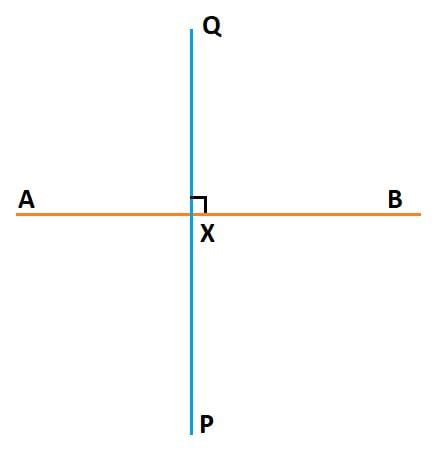Short & Long Question Answers: Parallel and Intersecting Lines | Mathematics (Ganita Prakash) Class 7 - New NCERT PDF Download
Q1: What is the measure of each angle formed when two perpendicular lines intersect?
Ans: When two lines are perpendicular, they intersect at right angles, each measuring 90°.
This is because when two lines cross and are perpendicular, they form 4 equal angles at the point of intersection.
A full circle around a point measures 360°.
So,
360°÷4=90°
Therefore, each of the four angles is 90°, making the lines perpendicular.
Q2: In a transversal intersecting two parallel lines, if one corresponding angle is 65°, what is the measure of the other corresponding angle in the pair?
Ans: When a transversal intersects two parallel lines, corresponding angles are always equal.
So, if one corresponding angle is 65°, then the other corresponding angle will also be:
Q3: A transversal intersects two lines, forming an interior angle on the same side of the transversal that sums to 180°. Prove that the two lines are parallel, and find the measures of the alternate interior angles if one is 75°.
Ans: Step 1: Proving the lines are parallel
When a transversal cuts two lines and the interior angles on the same side of the transversal add up to 180°, it means the two lines are parallel.
This is based on the Converse of the Consecutive Interior Angles Theorem, which states:
If the interior angles on the same side of a transversal are supplementary (sum = 180°), then the lines are parallel.
So, since the given interior angles add up to 180°, the lines are parallel.
Step 2: Finding the alternate interior angles
We are told that one alternate interior angle is 75°.
In parallel lines cut by a transversal, alternate interior angles are equal.
So, the other alternate interior angle is also:
75°
Q4: If a transversal intersects two parallel lines and one exterior angle is 130°, what is the measure of its corresponding exterior angle?
Ans: When a transversal intersects two parallel lines, corresponding angles, including exterior angles, are equal. If one exterior angle is 130°, its corresponding exterior angle is also 130°.
Q5: Fold a square paper horizontally twice to create three creases. Describe the relationship between these creases and the vertical edges of the paper, and explain why.
Ans: When a square paper is folded horizontally twice, it creates three horizontal creases.
These creases are:
Parallel to each other, and
Parallel to the top and bottom (horizontal) edges of the square paper.
Since the folds are made horizontally, they do not tilt or slant, and they run in the same direction as the horizontal edges.
The vertical edges of the paper are perpendicular to these creases. That means the creases and the vertical edges intersect at right angles (90°).
|
41 videos|251 docs|8 tests
|
FAQs on Short & Long Question Answers: Parallel and Intersecting Lines - Mathematics (Ganita Prakash) Class 7 - New NCERT
| 1. What are parallel lines and how can we identify them? |  |
| 2. What are intersecting lines and how do they differ from parallel lines? |  |
| 3. How can we determine if two lines are parallel using angles? |  |
| 4. What is the significance of the transversal in the context of parallel and intersecting lines? |  |
| 5. Can parallel lines ever intersect in a three-dimensional space? |  |





















